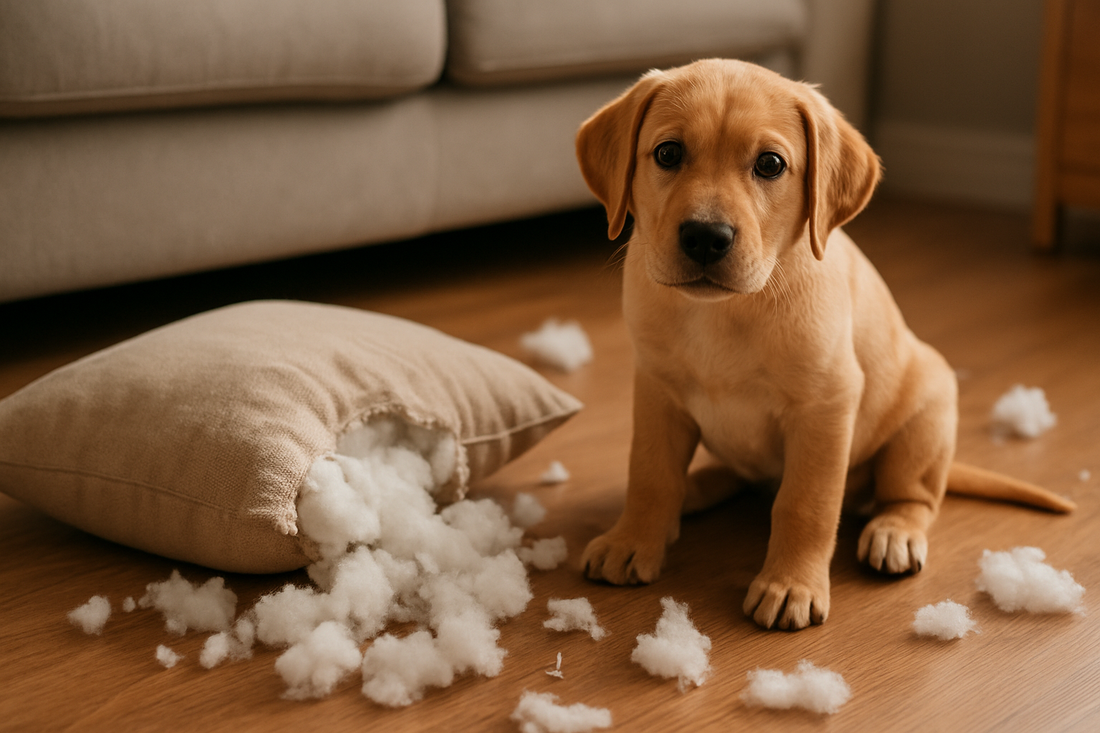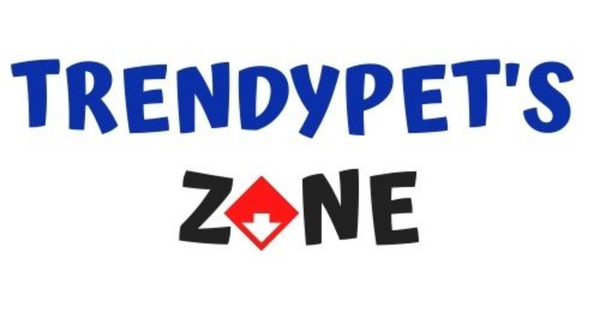
WHY IS MY DOG CHEWING EVERYTHING? 7 Proven Solutions
“Chewing is one of the most common behavior issues dog owners face - but it’s also one of the easiest to fix once you know the root cause.”
If you’ve ever come home to shredded shoes, chewed-up furniture, or destroyed pillows, you know how frustrating (and expensive) destructive chewing can be. The good news? Chewing is a completely natural dog behavior — and with the right approach, you can redirect it into something positive.
In this complete guide, we’ll cover why dogs chew, the most effective ways to stop it, and how to help your dog develop healthy chewing habits for life.
🐾 Why Dogs Chew?

Before fixing the problem, it’s important to understand why your dog is chewing everything in sight. Every dog has a reason — and once you identify it, solving the issue becomes much easier.
Teething (puppies) → Just like human babies, puppies go through teething stages that cause sore gums and discomfort. Chewing helps relieve that irritation. During this stage (usually between 3–6 months old), it’s vital to provide safe teething toys, frozen chew sticks, or soft rubber toys to protect your furniture.
Boredom → Dogs that lack stimulation often chew simply to entertain themselves. Without enough physical activity or mental engagement, they turn to whatever’s available — like your couch, shoes, or baseboards. Boredom chewing is especially common in intelligent breeds such as Border Collies, Labradors, and Huskies.
Spotting Boredom Before It Escalates → Dogs that chew from boredom often show other signs, like excessive barking, digging, or following you constantly. Providing daily structured playtime, interactive toys, and mini-training sessions can prevent boredom-related chewing before it starts. Even 10 minutes of fetch or hide-and-seek can redirect a dog’s energy positively.
Anxiety or Stress → If your dog tends to chew more when left alone, anxiety may be the culprit. Separation anxiety, sudden changes at home, or loud noises can trigger stress chewing. Dogs chew to self-soothe, similar to how humans might fidget or bite nails.
Instinct & Exploration → Dogs experience the world through their mouths. Puppies and even adult dogs use chewing to explore textures and scents. It’s an instinctive, investigative behavior — but without proper direction, it can lead to chewed-up belongings.
Medical Causes (rare) → In rare cases, chewing can stem from nutritional deficiencies, dental pain, or gastrointestinal issues. If your dog’s chewing seems obsessive, sudden, or focused on unusual items (like rocks or walls), schedule a vet visit to rule out medical causes.
Breed & Age Considerations → Some dogs are naturally more prone to chewing due to breed traits. Working breeds like Border Collies, German Shepherds, and Huskies often need more mental stimulation and can develop chewing habits if under-stimulated. Senior dogs may chew less overall, but chewing can sometimes indicate dental discomfort or cognitive changes. Recognizing these differences helps tailor the right solution for your dog’s needs.
✅ 7 Proven Solutions to Stop Excessive Chewing
Now that you understand the “why,” let’s talk about how to fix it. These seven proven techniques can help you protect your home — and give your dog healthier ways to satisfy their natural chewing instincts.
1. Provide the Right Chew Toys - Satisfy their instincts.
 Dogs will chew something — so make sure it’s the right thing. Offer durable chew toys like Kong Extreme, Nylabone DuraChew, or rope toys that are safe and built to last.
Dogs will chew something — so make sure it’s the right thing. Offer durable chew toys like Kong Extreme, Nylabone DuraChew, or rope toys that are safe and built to last.
Extra Tips:
- Rotate toys every few days to keep them “new and exciting.”
- Consider natural chews like bully sticks or antlers, but supervise use to avoid choking hazards.
- Soft toys are great for gentle chewers, while tough rubber toys work for heavy chewers.
Pro Tip: Stuff a Kong with peanut butter or freeze it with yogurt and treats — it can keep your pup busy for hours and satisfy their chewing urge in a positive way.
2. Increase Daily Exercise - Tire out that energy.
 A tired dog is a happy (and well-behaved) dog. Many chewing problems come from pent-up energy.
A tired dog is a happy (and well-behaved) dog. Many chewing problems come from pent-up energy.
Exercise Tips:
- Aim for at least 60–90 minutes of physical activity daily for high-energy breeds.
- Mix up your routine: try fetch, tug-of-war, or agility-style games.
- Don’t underestimate walks: sniffing and exploring mentally tires dogs, not just physically.
- Combine physical exercise with mental challenges, like a short agility course in the backyard or a training session at the park.
When dogs are properly exercised, they’re less likely to channel excess energy into destructive chewing.
3. Offer Mental Stimulation - Keep their brain busy.

Chewing isn’t always about energy — it’s often about mental boredom. Dogs need brain work just as much as body work.
Ideas for Mental Enrichment:
- Puzzle toys and treat-dispensing balls
- Hide-and-seek games with treats
- Obedience or trick training sessions
- Snuffle mats or DIY scent games
Even 10–15 minutes of problem-solving can make a huge difference. Teaching new tricks weekly, like “spin” or “bow,” can provide both fun and mental exercise. A mentally engaged dog is calmer and more content.
4. Use Safe Deterrent Sprays

If your dog keeps targeting furniture, shoes, or cords, consider using a pet-safe deterrent spray. These sprays taste bitter, making items less appealing.
However, deterrents only work when combined with training and redirection. Spray the off-limits area, then immediately give your dog an appropriate chew toy and praise them when they choose it.
Never use strong chemicals or home remedies (like hot sauce or vinegar) — these can irritate your dog’s mouth or skin.
5. Redirect with Positive Reinforcement

Dogs learn best through positive association. When your dog chews the correct item — such as a toy or bone — praise, pet, and reward them with a treat.
Avoid scolding or yelling if they grab something off-limits; instead, calmly take the item away, replace it with a chew toy, and reward them when they engage with it.
Consistency is key: everyone in the household should follow the same approach. If one person allows the dog to chew old socks as toys, they’ll assume all socks are fair game!
6. Address Anxiety Triggers - Create a calm environment

If your dog’s chewing is linked to stress or separation anxiety, addressing the emotional cause is crucial.
Here’s what can help:
- Safe Space: Create a cozy, familiar area with their bed, favorite toy, and soft lighting.
- Interactive Toys: Leave puzzle feeders or slow-release treat toys when you go out.
- Calming Music: Soft background music or white noise can reduce anxiety.
- Gradual Desensitization: Practice short departures to help your dog get used to being alone.
For severe anxiety, consult a certified dog trainer or vet behaviorist. In some cases, professional support and structured training plans can make all the difference.
7. Schedule a Vet Check - Rule out medical issues

If chewing seems new, excessive, or obsessive, schedule a vet visit.
Dental problems, nutritional imbalances, or pain can all lead to unusual chewing behavior. Your vet can check for issues like broken teeth, gum irritation, or underlying health conditions..
❌ What NOT to Do
Knowing what not to do is just as important as knowing what to do.
🚫 Don’t use crates as punishment. Crates should always feel safe and comforting, not like “doggy jail.”
🚫 Don’t punish after the fact. Dogs won’t connect the scolding with the earlier act of chewing.
🚫 Don’t take away chewing entirely. It’s essential for dental health, stress relief, and emotional balance.
🚫 Don’t ignore early signs. Occasional chewing can quickly become a habit if left unaddressed.
⚠️ Common Mistakes to Avoid
Even well-meaning owners can make mistakes when trying to stop destructive chewing. Avoid these pitfalls:
- Inconsistent rules: If your dog sometimes gets away with chewing an old slipper, they’ll think all shoes are fair game.
- Skipping exercise: Physical and mental enrichment are not optional — they’re essential.
- Using inappropriate toys: Low-quality toys can break or splinter, creating choking hazards.
- Neglecting crate training: A properly introduced crate can be a safe, chew-free zone for unsupervised time.
Consistency, supervision, and patience go a long way in building lasting good habits.
🏠 Prevention Tips for a Chew-Free Home
Preventing destructive chewing is about setting your dog up for success.
- Puppy-proof your home: Remove tempting objects like shoes, remotes, and kids’ toys from floor level.
- Provide variety: Offer different textures — rubber, rope, nylon, plush — to see what your dog prefers.
- Establish a routine: Dogs thrive on predictability. Consistent feeding, walking, and play schedules reduce anxiety-driven chewing.
- Supervise and redirect: Watch your dog closely during play and gently redirect them when needed.
Daily Routine Matters
A predictable daily schedule helps dogs feel secure. Rotate chew toys and interactive games regularly to keep your dog engaged. Structured routines reduce anxiety, boredom, and the likelihood of destructive chewing.
🎯 Final Thoughts
 Chewing doesn’t have to mean chaos. With the right combination of toys, exercise, mental stimulation, and positive reinforcement, you can guide your dog toward healthy chewing habits — and protect your home in the process.
Chewing doesn’t have to mean chaos. With the right combination of toys, exercise, mental stimulation, and positive reinforcement, you can guide your dog toward healthy chewing habits — and protect your home in the process.
Start small:
➡️ Pick one new durable toy.
➡️ Add an extra 15-minute walk.
➡️ Try a puzzle feeder this week.
Example Success Story:
Bella, a high-energy Labrador, used to chew shoes daily. Her owner added a puzzle feeder, two new durable toys, and 20 extra minutes of play per day. Within two weeks, Bella chose her toys over shoes — showing how small, consistent changes make a huge impact.
You’ll be amazed at how quickly your dog’s chewing habits improve when their needs are met — both physically and mentally.
👉 Check out our Best Dog Toys for Heavy Chewers - durable, safe, and vet-approved favorites that satisfy your pup’s natural urge to chew while keeping your home damage-free.
🐶 Ready to protect your home and keep your dog happy?
Shop our Dog Toys Collection
Tags: dog care, dog chewing furniture, dog destructive chewing solutions, puppy chewing phase, stop dog chewing, dog chewing, destructive chewing, dog behavior tips, puppy teething, separation anxiety dogs, chew toys
